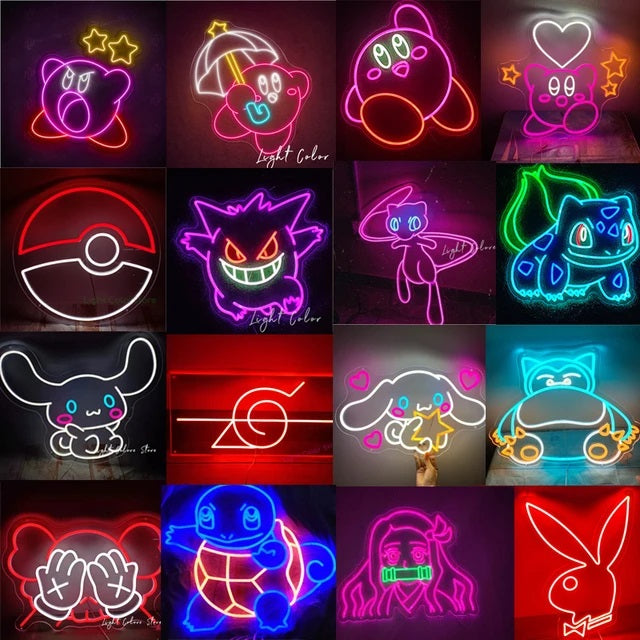Neon Sign Transformer: Important Information To Know
Neon sign transformer plays a crucial role in bringing the vibrant glow of neon lights to life. These specialized transformers are designed to provide the high voltage needed to ionize the neon gas inside the glass tubes, creating the distinctive and mesmerizing glow for which neon signs are famous. Let's learn more with Orant Neon through the article below!
1. What type of transformer does the neon sign use?
A transformer explicitly designed to supply power to a LED neon is known as a neon sign transformer. They transform line voltage, which ranges from 120 to 347 V, up to high voltages, between 2 and 15 kV. These transformers deliver between 18 and 30 mA; 60 mA is available upon request. Luminous gas discharge tubes use neon or other gases that high-voltage electricity excites.
Electronic neon transformers are typically solid-state transformers that use electronic components, such as transistors and diodes, to convert the incoming low-voltage AC power from the electrical grid to the high-voltage AC output required for LED neon. They are compact, lightweight, and energy-efficient compared to traditional electromagnetic transformers.
Besides, they often have multiple secondary windings to accommodate different configurations of neon tubes and gas mixtures. They may also have built-in safety features like short-circuit protection and ground fault detection.
It's crucial to follow the manufacturer's instructions and safety guidelines when selecting, installing, and operating a neon sign transformer to ensure the safe and reliable operation of signs.

Neon light transformer with compact and energy-saving design
>>> Read more: Neon Light Voltage: Everything You Need To Know
2. What size transformer do neon signs need?
The size of the transformer needed for a LED sign depends on various factors such as the length and diameter of the neon tubes, the type and color of the gas used, and the desired brightness of the sign. Neon sign transformer is typically sized based on their output voltage and power capacity.
According to the needs of an application, transformers are typically employed to either step up or down the voltage. Aa step-up transformer is utilized to illuminate the signs because they need a high voltage. Both a primary and a secondary winding are present.
These are wound on iron cores, with the secondary winding linked to the equipment and the primary winding connected to the mains. The secondary winding supplies the required high voltage between 2 and 15 kV. The output current goes from 30 mA to 60 mA, while the line voltage ranges from 120V to 240V.
The power capacity of a neon sign transformer is typically chosen based on the total power requirements of the LED sign, including the sum of the power required for each neon tube in the sign.

Transformers are often used to increase or decrease voltage
>>> Refer: How To Create Eye-Catching Custom Signs For Bussiness Store
3. How does neon sign transformer work?
A neon sign transformer, also known as an electrode transformer works by converting the incoming low-voltage alternating current (AC) power from the electrical grid into the high-voltage AC output required to ionize the neon gas inside the glass tubes of a LED sign, creating the characteristic glow.
Here are the working principles of how a neon light works:
- Neon uses inert neon gas. These signs are constructed using tubes that contain this gas.
- This tube supplies the high voltage obtained from the transformer. The high voltage they provide will increase the kinetic energy of the electrons in the neon atom.
- Ionized will develop a positive or negative charge on the atom. These charged atoms can create a plasma that carries electricity from one end of the tube to the other. During this process, Plasma will be formed to complete the circuit and cause the electrons in the atom to drop to the average level from the excited state.
- A photon will be emitted when the electrons return to their average energy level. At the same time, this photon illuminates the neon lights.
- As a basic rule high voltage must be supplied to the neon gas for lighting. Transformers always supply this high voltage.

High voltage must be supplied to neon gas for lighting
>>> Read more: What Neon Sign Parts Are There? Find Out Details
4. Do neon lights run on AC or DC?
Neon lights, or LED signs, typically run at high voltage alternating current (AC) power. A neon sign transformer, which is used to power neon lights, typically converts the incoming low voltage AC power from the electrical grid into higher voltage AC output required to ionize the neon gas inside the glass tubes and create the characteristic glow of neons.
The high voltage AC output from the neon lights creates a high electric field within the neon tubes, causing the neon gas to ionize and produce the characteristic glow. The ionization process involves the flow of charge particles or ions, requiring alternating current to reverse the flow direction continuously.

The atoms in the tube can move around and collide with each other. They transfer energy to each other, plus a lot of heat will be generated. While some electrons escape their atoms, others gather enough power to become "excited." This means they will have a higher energy state.
It's worth noting that some modern LED neon may use direct current (DC) power in specific applications, such as automotive or marine applications, where DC power is more readily available. However, the majority of traditional signs, as well as the neon sign transformers designed to power them, operate on AC power.
The magic of custom neon signs lies in their ability to shape and illuminate your specific message or design in vivid, captivating colors. Whether you want to bring life to a commercial storefront, add a whimsical touch to a party, or lend a unique ambiance to your living space, custom neon signs can make your vision a reality. Just like any other neon signs, custom neon signs rely heavily on the neon sign transformer. When creating a custom sign, you need to ensure that the transformer's voltage and power capacity are properly sized based on the total length and configuration of the neon tubes in your sign. Your design's complexity may require multiple secondary windings on the transformer, especially if your sign has different sections or colors that can be independently controlled.
Related more:
A neon sign transformer is essential in creating LED signs' captivating glow. Understanding the safety precautions, sizing and selection, quality, and maintenance requirements of neon sign transformers is crucial for anyone working with or interested in neon lights. If you need to learn more, don't hesitate to contact Orant Neon immediately!



6 comments
Dan
@ Ron yes you can use the regular 30ma instead of the 35ma. We use 30ma on all our signs regularly and we use a 60ma transformer in the shop to burn in any tubes that aren’t lighting bold enough/too pale (think when a clear red neon tube comes in pale pink. Attach a 60ma transformer for a half hour and it’ll “charge” it right up to that red neon) So the difference will be negligible for your situation.
@ Bobby. What are you even asking. Please stay away from transformers you are gunna get someone hurt. Professional use only.
@dale. I hate that too. Neon led? That’s like saying human robot. But yeah sorta do the same thing, one just uses way less output power. (Don’t plug LED lights into a core and coil transformer. Use solid state).
I don’t work for this company I just build neon signs for a living and can’t stand stupid questions. Google is your friend. Read. Learn. It’s fun.
@ Ron yes you can use the regular 30ma instead of the 35ma. We use 30ma on all our signs regularly and we use a 60ma transformer in the shop to burn in any tubes that aren’t lighting bold enough/too pale (think when a clear red neon tube comes in pale pink. Attach a 60ma transformer for a half hour and it’ll “charge” it right up to that red neon) So the difference will be negligible for your situation.
@ Bobby. What are you even asking. Please stay away from transformers you are gunna get someone hurt. Professional use only.
@dale. I hate that too. Neon led? That’s like saying human robot. But yeah sorta do the same thing, one just uses way less output power. (Don’t plug LED lights into a core and coil transformer. Use solid state).
I don’t work for this company I just build neon signs for a living and can’t stand stupid questions. Google is your friend. Read. Learn. It’s fun.
Ron
I want to know if i can replace my 6kv 35mv neon transformer with a 6.5kv 30mv ?
It’s hard to find 6k with 35mv
I want to know if i can replace my 6kv 35mv neon transformer with a 6.5kv 30mv ?
It’s hard to find 6k with 35mv
Roger Browne
Dear Sir,
I have build a Tesla coil and have purchase A neon light transformers 15000 Volts at 60Ma
I no that I have to depot it to remove a few things dose any bobby no where I can get wire diagram for a Allanson transformer or a Jefferson Electric 724-411 transformer.
Regards Roger.
Dear Sir,
I have build a Tesla coil and have purchase A neon light transformers 15000 Volts at 60Ma
I no that I have to depot it to remove a few things dose any bobby no where I can get wire diagram for a Allanson transformer or a Jefferson Electric 724-411 transformer.
Regards Roger.
Roger Browne
Dear Sir,
I have build a Tesla coil and have purchase A neon light transformers 15000 Volts at 60Ma
I no that I have to depot it to remove a few things dose any bobby no where I can get wire diagram for a Allanson transformer or a Jefferson Electric 724-411 transformer.
Regards Roger.
Dear Sir,
I have build a Tesla coil and have purchase A neon light transformers 15000 Volts at 60Ma
I no that I have to depot it to remove a few things dose any bobby no where I can get wire diagram for a Allanson transformer or a Jefferson Electric 724-411 transformer.
Regards Roger.
Roger Browne
Dear Sir,
I am looking for some one to make me 2 secondary winding for a Allanson neon light transformer 15000 volts at 30 Ma to 60 Ma or could I make them?
Regards Roger.
Dear Sir,
I am looking for some one to make me 2 secondary winding for a Allanson neon light transformer 15000 volts at 30 Ma to 60 Ma or could I make them?
Regards Roger.
dale luck
Why do you say “LED neon”. LED lights typically use a much lower voltage. I thought this is about GAS neon lights.
Why do you say “LED neon”. LED lights typically use a much lower voltage. I thought this is about GAS neon lights.